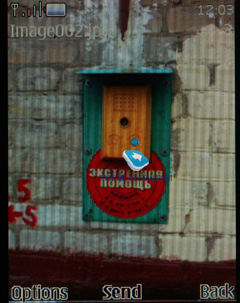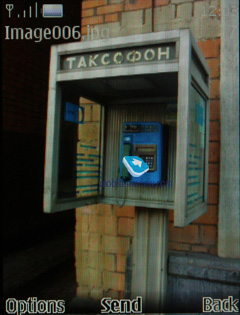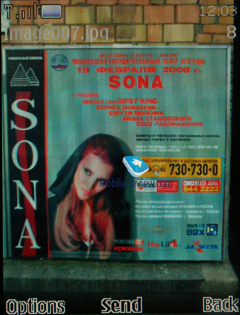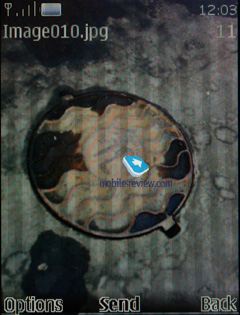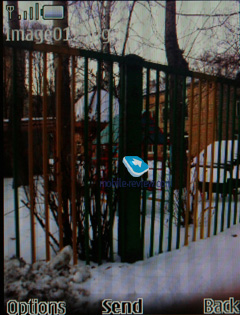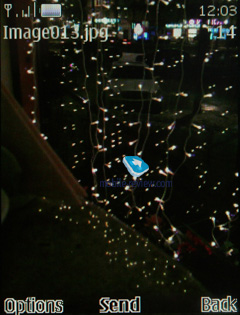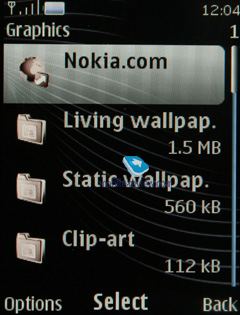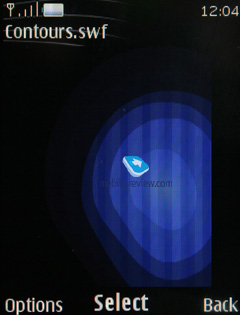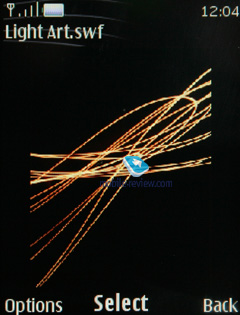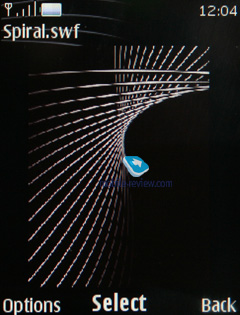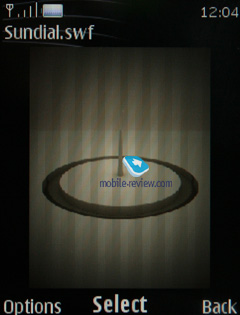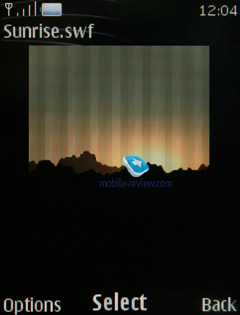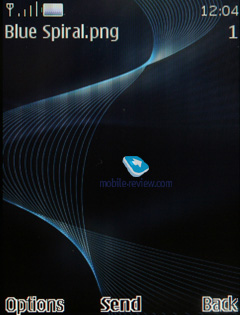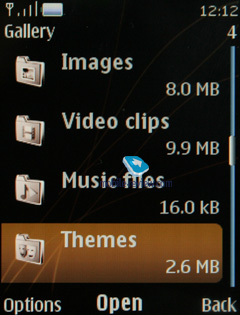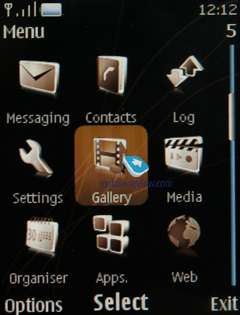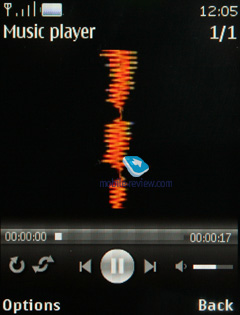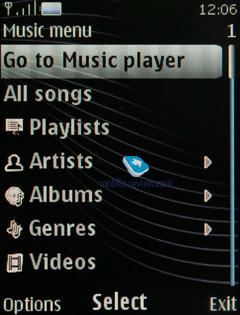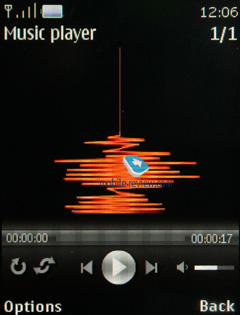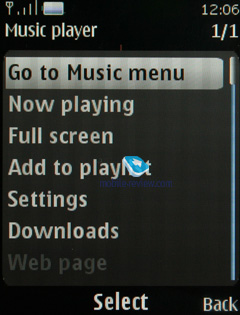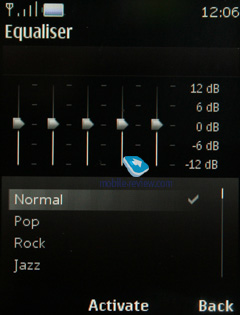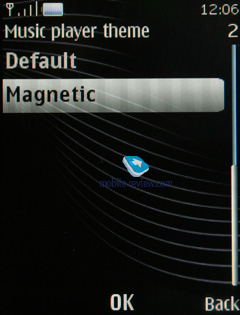|
|
Review of GSM/UMTS-handset Nokia 8800 Arte/Sapphire Arte
Live photos of Nokia 8800 Arte
Table of contents:
- Positioning
- Design, size, controls
- Display
- Keypad
- Battery
- Memory
- Performance
- USB, Bluetooth
- Camera
- Themes, applications, games, extras
- Impressions
Sales package
- Handset
- Battery
- Charger
- USB data cable
- Desktop cradle
- Bluetooth-headset (Nokia BH-803)
- User Guide
Positioning
Every manufacturer secretly dreams of rolling out something like the Nokia 8800 one day. A premium solution with low production costs, tremendous image of a fashion-savvy phone and sales that are way beyond expectations. However, nobody has managed to repeat the trick pulled off by Nokia, and all attempts have been getting cold welcomes from consumers. The end of 2007 sees a new twist in this story – phone makers are getting serious about precious metals and stones in their offerings. Remember the Motorola RAZR2 Luxury Edition with its 18- and 24-carat gold parts and the rear finished in snake leather. This beauty will set you back about 1000 Euro, just like its league mate, the Nokia 8800 Sirocco Gold.
However it is not Nokia’s primary offering – the Sirocco line is a sub-class of the Nokia 8800 family, and that’s all there is to it. What it is really aiming to accomplish is to take everything one step further and increase the phone’s price, otherwise, Nokia portfolio for the top price-bracket won’t be seeing a substantial sales growth. And on top of that the arrival of new and steeper models justifies hefty price tags of junior offerings, especially as far as fashion-savvy phones are concerned. This is a decent trick that boosts prices for this particular maker’s products in general and drives them up to a slightly higher price segment. This worked out for the 8000-series, why shouldn’t they believe it will do the job these days as well?

From the empirical point of view, the price of any premium model can grow up to the level when it goes for as much as 1\2 of a junior Vertu-branded model, in other words – 2000 Euro or so. Past this watermark, the price might get consumers thinking – whether they are willing to wait some time and get a Vertu, since its life cycle will be longer anyway (Vertu doesn’t tend to revamp its line-up with never-ending announcements, depreciating original solutions). That’s why we have all reasons to expect the company to start making its way in this direction.
The word “Arte” stands, like you probably have already guessed, for “art”, which is a truly profound act on Nokia’s part – while it kept the 8800 number in place and thus put the new offerings in one line-up with their predecessors, on the other hand, for some time it will be very easy to get lost in names and order of releases (which model came out when). Arte’s generic design also adds to this confusion. However for the phone’s target audience it becomes vitally important to emphasize that they own the latest and greatest handset of the series, rather than some already-long-in-the-tooth original Nokia 8800 – they want everyone to know that they are at the cutting edge with their Arte, or, even better, Arte Sapphire. This principle is what all sales of this series hinge on – Nokia needs to roll out new, and, curiously, more expensive solution, working in a way opposite to the mass market; in this case every next product should wear a heftier price tag, rather than drop in price.

Effectively, all iterations of the Nokia 8800 have been popular – some more, some less, but in this price segment it is the phenomenon that is unparalleled up until today, as there hasn’t been any other product that could boast such a stable demand over a long period of time. Will the Arte jump in one line with its predecessors? Definitely, this handset is positioned as a democratic luxury, being the best device you can grab among relatively mass-production devices.
Back to the table of contents >>>
Design, size, controls
The casing still enjoys stainless steel design, and the Nokia 8800 Sapphire Arte shows off leather finish on the rear and the front fascia on top of that. This leather is imported exclusively from western India, then gets proper treatment and attached to the casing. Vertu’s leather insets are normally described in a pretty much similar fashion. However as soon as someone gets his mitts on this leather coating its beauty won’t last too long – usually it grows pale and worn in 6-9 months’ time. No idea whether the Nokia 8800 Sapphire will share the same fate or not, but I don’t really believe in miracles.
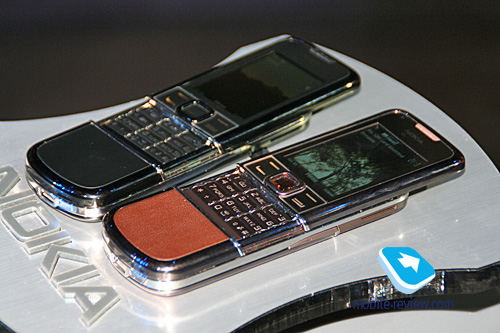
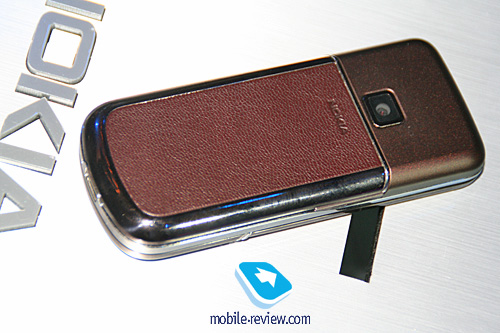
The owners of the Nokia 8600 know from their own experience how easily their phones pick up fingerprints and grease all thanks to its glass finish. The original Nokia 8800 and all its editions never had problems with this. And all the more surprising it was to find a mention of “Anti-fingerprint coating on metal and glass” in Nokia’s official press-release. What the maker himself starts outlining these things beforehand, then it is no good at all – some real problems are coming.




Even today, both versions of the Nokia 8800 Arte can be considered for “The most grease-prone handset ever” title hands down. Really, I can’t remember a phone that was so easy to grime. Both the Motorola U9, and the Sony Ericsson Z750i, although they both employ glass-like finishes, are in a completely different league. Obviously, beauty knows no pain, but I have a feeling that THIS pain will get through.
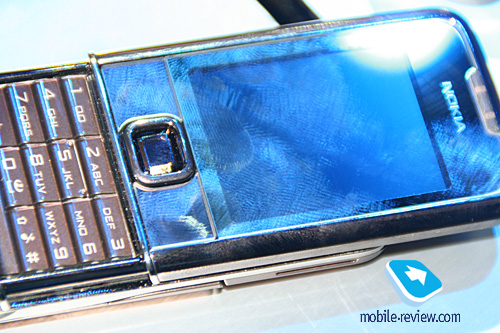
One of the Sapphire Arte’s highlights is its OK button that has been replaced with a synthetic sapphire color-keyed to the casing’s trim. While it looks like a marvelously sparking beauty in the official photos, in real life it seems somewhat recessed into the casing, and I assure you, nobody will ever tell the difference between a piece of polished plastic an a synthetic sapphire. That’s why this sapphire inside is just another sweetener for fashion-conscious buffs, since it brings no other apparent benefits and doesn’t look much different from plastic. No, really, I can readily believe that tomorrow we’ll see a crowd of experts who can tell for sure whether it is a piece of plastic or a sapphire after having a mere glimpse of the phone. Certainly, some owners of the Nokia 8800 Arte will be a hundred percent convinced that their phones house a sapphire instead of the center key. But don’t mistake someone’s wild dreams for something a bit more real.
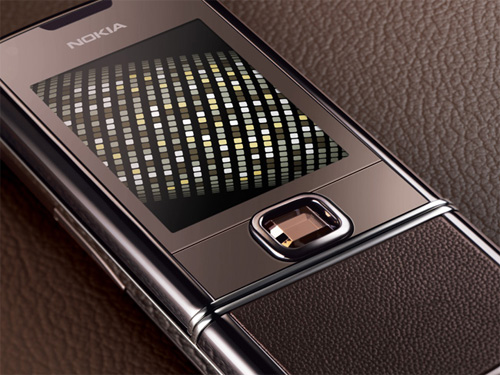
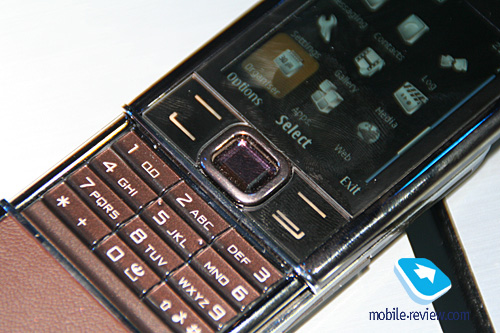
The European association of professional jewelers has already made a name for it by frowning over why they called the stone embedded in the Nokia 8800 Arte Sapphire a “sapphire” – as they claim this name is to be used only with natural stones, while synthetic crystals can’t qualify. That’s another way you can fight for an own small on the market. At first, Nokia’s didn’t seem to bother much about this, but eventually they decided to keep the “Sapphire” part in, but refrain from using the “gemstone” word, that refers to real sapphires which were kept under the pressure of Earth’s crust for millions of years. In my opinion, it is a quite remarkable collision, for, in truth, they couldn’t call a synthetic stone a real sapphire and the changes they made are fully justified. On the other hand, though, the are boatloads of offerings on the market capitalizing on “Gold”, “Platinum”, “Diamond” and other big names, although their parts that are styled after certain precious metals or gemstones in the end are nothing but plastic mimicking gold/platinum or synthetic crystals. In these cases consumers are not misled, and nor are manufacturers, as they by no means imagine they are selling something extremely pricey or precious. That’s why the situation around the Nokia 8800 Sapphire Arte is more of an anecdote. Interestingly, the owners of the Nokia 8800 SE Gold knew it from the very beginning that the casing of their device wasn’t golden, but rather painted to look this way – this didn’t put them off, however.
As for other things of note, the navigation button found in the black Nokia 8800 SE has a nacreous plastic inset, but it still looks like a gemstone, if you put some imagination into it.


Generic style is the characteristic feature of the 8000-series, and the Arte isn’t an exception. Put the Arte and the black version of the Nokia 8800 SE shoulder to shoulder, step three meters away from them and try to figure out where the Arte is – quite a challenging task, dare I say. The company’s intentions are actually twofold – firstly, they want to cater for those who have grown accustomed to their black Nokia 8800s; secondly they are offering the most expensive solution in a different color, making it more sought-after. That’s why the market will see the “no-frills” edition of the Arte, while its sapphire iteration will debut two months later. Price-wise the difference between them doesn’t seem substantial keeping in mind what class these phones act in, although, probably, at first it will be considerable in view of the senior offering being new and hot. If you are in the market after the most fashion-savvy device, then the Nokia 8800 Sapphire Arte should be your pick, for visually it is more recognizable thanks to its brown color scheme, a gemstone mounted in the place of the OK button and leather accents.
Nokia 8800 Sapphire Arte:

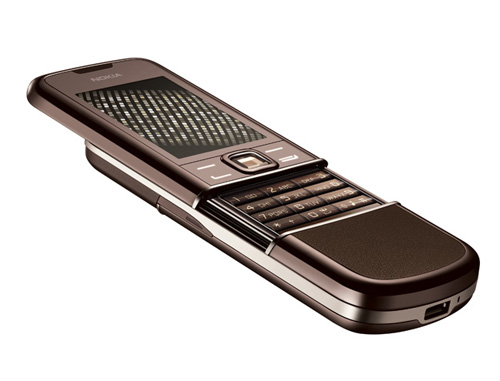
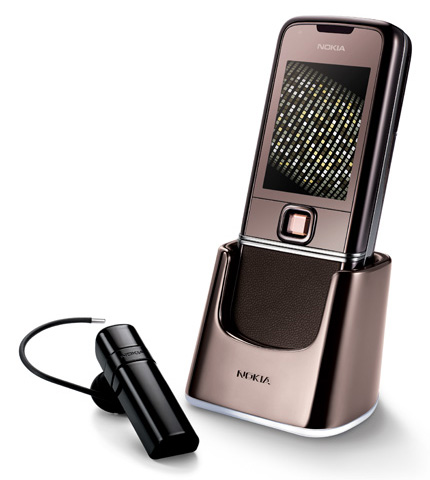
Nokia 8800 Arte:

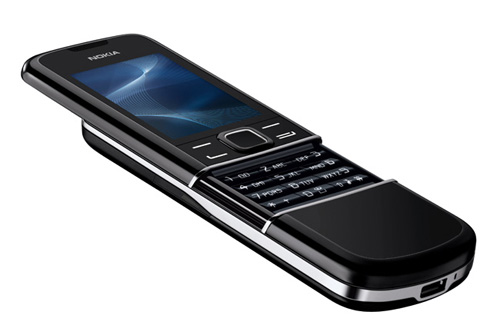

The handset measures up at 109x45.6x14.6 mm, tipping our scales at 150 grams – while its dimensions have shrunk a little as compared to the Sirocco Edition, its weight, on the contrary, has increased by 12 grams. This doesn’t make all the difference, however, the Arte delivers a nice weighty feel and hasn't been criticized by the owners of the 8000-series devices for being too much of a heavyweight so far. Here is another interesting psychological gimmick – almost all devices of this type are quite heavy, be it Vertu or Nokia-branded solutions or someone else’s. In other words, they feel like quality things in your hands. And that’s the right thing to do, since most people’s judgment on build quality is greatly affected by presence of metallic accents and weight. As far as the mass-market goes, the only manufacturer that takes advantage of this trick is Apple with its first handset.





The Arte can be carried in shirt’s pocket, if you are not afraid to stretch your favorite shirt. One of our readers once told me that it was a real disaster with his Nokia 8800 SE, though my personal opinion won’t matter much here, since I prefer jeans and casual clothes, so all phones of mine end up in other pockets. The handset comes boxed with a leather holster, which is pretty tight, but comes with a strap pulling which releases the handset – this small feature adds a whole lot of value to it.





The Arte’s build quality is absolutely supreme – nothing we can fault it for. Its parts are well-attuned to each other, no gaps between details, and it feels rock solid while in the hand. But we become really nitpicky some models have a tiny gad between the navigation cluster and silver rim that gets exposed by activating the backlighting.



Unlike the previous models, the camera is mounted on the rear with no lens cover, meaning that fingerprints are frequent guests on the lens. We will look into the Arte’s camera in a dedicated section of this review, but for now let me note that fingerprints don’t ruin snaps all that much.
Sitting on the top is the power button, while the opposite end houses the microUSB socket used for plugging in data cables, headsets and chargers.
The Arte comes equipped with a single loudspeaker integrated into its right-hand spine. As you would expect from an 8800 model, it packs in no volume rocker – they have forgone it, thinking that it would not make for a sturdy casing.

The only thing left to point out is that upon sliding the phone open you will hear a distinctive “click” sound, which is a trademark feature of the 8000-series – some people just love and can waste hours opening and shutting their devices solely to hear this sound and feel how the parts are moving back and forth.

Back to the table of contents >>>
Display
The phone utilizes a 240x320-pixel OLED display measuring 2 inches from corner to corner, capable of up to 16 million colors (the same unit is retained by the Nokia 7900 Prism). Unlike the Nokia 6500 Classic (TFT), here the user is enabled to adjust display brightness. The display found in the Arte is pretty good and puts up a relatively bright picture.
Many were curious what can an OLED-display bring what a TFT unit is incapable of. The answer isn’t as clear-cut as you might think at first – it is more appealing largely to the fact that it consumes less energy, hence the ability to adjust display brightness, which the predecessors lacked. Compared to the Nokia 6500 Classic, the Nokia 8800 Arte’s display holds the upper hand not thanks to its brightness, but juicer colors; although they may seem less natural at times, they add up to a picture that looks smoother and a tad blurry, and thus more eye-candy. While the Arte’s display looks like a winner here, in real life, given its dark color schemes, you simply won’t see the difference.





The OLED display is a better performer under direct sunlight, plus the bundled ambient light sensor adjusts the screen’s backlighting automatically, rendering texts more readable, especially indoors.
The display accommodates up to 8 text and 3 service lines. The font is pretty big and certainly readable; its size can be altered.
Back to the table of contents >>>
Keypad
The navigation cluster is designed as it if they composed of touch-sensitive controls – that is, it consists of one glossy black slab with the navi button inside. At a glance you really start to think that the Arte employs touch pads, however in fact it is not the case here. The handset makes use of mechanical buttons that reveal their true nature right after a couple of first taps. This approach has a whole lot of positives to it – first, it lends the Arte a spectacular looks, while benefiting from the ergonomics of conventional keys. Similar design is used in the Nokia 5610.


The phone’s four-way navigation button is smallish and won’t appeal to everyone – occasionally it feels fiddly to use, and while the Sapphire Arte offers slightly better ergonomics for the navi pad, it doesn’t make that much of a difference.
The glossy number pad is styled after the previous 8800 handsets. All keys are quite easy to use, we had no complaints about their ergonomics. The top part of the sliding portion of the handset has a small slope that makes the bottom row of the keypad more accessible.


The keypad is lit in white, which is well-visible in various environments. The Arte also comes armed with an ambient light sensor that handles backlighting levels automatically.
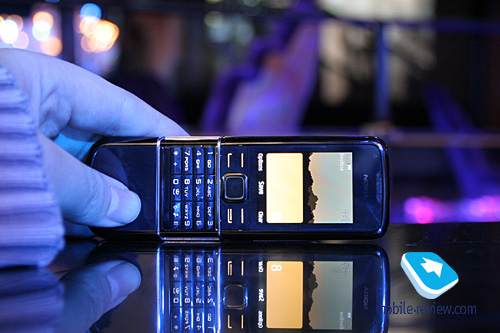

Back to the table of contents >>>
Battery
The Nokia 8800 Arte utilizes a 1000 mAh Li-Ion battery (BL-4U). As the manufacturer claims, this cell can provide up to 320 hours of standby and 3 hours of talk time.




In Moscow the handset lasted around 2 days (1.5 hours of calls, 6 hours of music, up to one hour of playing with other features). Overall, the battery life of the Arte shows a 25-30 percent improvement over the previous devices, which is a substantial progress. The bitter experience of the Nokia 8800, when the phone could stay online for only one day, made the maker put an extra battery into its box; in its turn, the 8800 Arte comes packaged with one. As I see, 2 days of battery time with heavy use is a pretty good performance for a phone of this type. Even if you will be extremely heavy on its calling features, the Arte will stay up and running up to a day. Full charging time – less than 2 hours.
The Arte comes boxed with a desktop cradle that can recharge the handset. Among its fortes is the fact that it is made of metal and therefore looks superb; it won’t make you look ashamed no matter where you place it – at home or in the office. Those who still don’t know what kind of rapture a cradle charging the phone up bring, will become addicted to it in an instant. Regrettably, you can connect only one cable to it at a time, so there is no way to have the phone charged and synchronized with PC at the same time.


Back to the table of contents >>>
Memory
The phone comes in with 1 Gb of storage space onboard, no memory expansion slot, however. The entire memory bank is divided up into two parts – for storing music, video and images, and for PIM applications (22 Mb), specifically its Organizer, Phonebook and SMS messages.
Back to the table of contents >>>
Performance
The phone is a typical offering for its generation – no bells and whistles here.
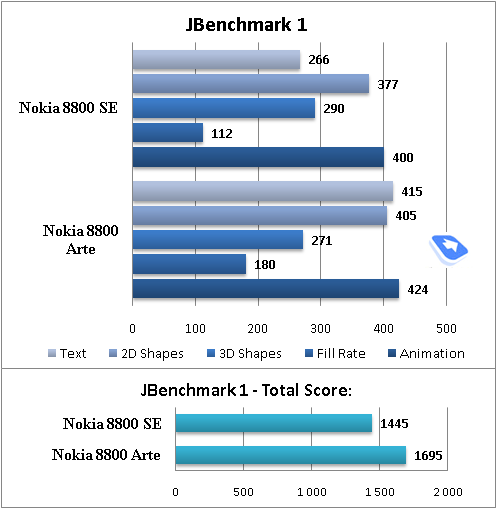
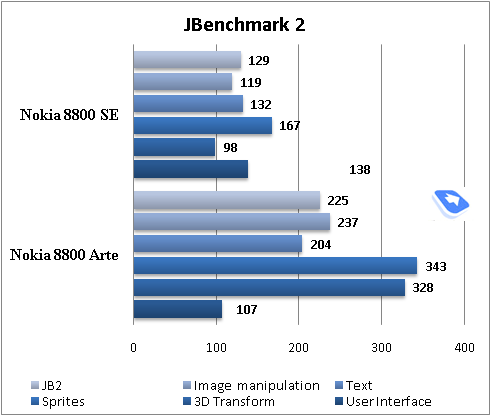
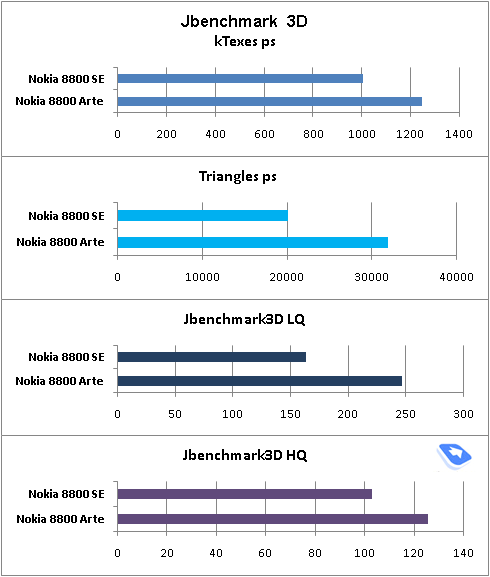
Back to the table of contents >>>
USB, Bluetooth
USB. Much like the Nokia 6500 Classic/Slide, the Arte makes use of a microUSB slot placed on the top end. This socket kicks in when you connect data cable, charger or headset.
The vendor says that the handset supports USB 2.0, and it does indeed, in USB Mass Storage mode the connection via USB cable puts up medium data transfer speed which makes up about 500-600 Kb/s. This is slower than the Motorola RAZR2 V8, which also comes installed with microUSB-socket.
Upon successful connection you can pick one of the following modes: USB Mass Storage, PC Studio, or modem mode. Also, the handset starts recharging regardless of mode you pick. There is no support for MTP mode, music tracks have to be moved onto the phone manually.
Bluetooth. The handset comes with EDR-enabled Bluetooth 2.0. The following profiles are supported:
- Dial-Up Networking Profile
- Generic Access Profile
- Generic Object Exchange Profile
- Object Push Profile
- Serial Port Profile
- Handsfree Profile
- Headset Profile
- Synchronization Profile
- Basic Image Profile
- File Transfer Profile
- HID (host) Profile
- Stereo Advanced Audio Distribution Profile
- Advanced Audio/Video Remote Conference Profile
- A2DP
The Bluetooth implementation is, as always though, nothing to complain about, we encountered no issues with handling this type of connections.
Back to the table of contents >>>
Camera
The handset utilizes a 3.2 Mpix camera, which is in effect identical to that of the Nokia 5610 XpressMusic and Nokia 6500 Slide. But unlike these two phones, the Arte employs a much less sophisticated lens, and thus, is more of a disappointment on this front.
Spec-wise, these two camera modules are identical. The following image resolutions are supported:
- 2048õ1536;
- 1600õ1200;
- 1280x960;
- 640x480;
- 320x240;
- 160x120.

Three JPEG compression settings are supported: basic, normal, high. Speaking of other options, you can adjust the shutter sound (on/off), take advantage of x8 digital zoom, modify the white balance settings, ISO level, etc. Overlays may be applied to all taken snaps, so whether it’s worth using them before shooting or not – it is all up to you. The following effects are onboard: Greyscale, Sepia, Negative.

For those keen on the multi-shot mode, there is an option in the Arte slide that makes the camera take up to 3 shots in a rapid succession, while all settings remain identical to the single-shot mode, including resolution. There is also a 10-second self-timer available.
The camera interface employs the landscape layout, which looks really reminiscent of the Series 40v3 devices, and there is nothing special about it – shooting with the Arte is pretty comfortable. The snaps taken with the Arte look good while on the phone’s display and disappoint when viewed on a PC screen. In poor lighting shots are usually spoiled by a ton of noises, so the camera becomes nearly useless.
 |
 |
| (+) maximize, 1536õ2048, JPEG |
(+) maximize, 1536õ2048, JPEG |
 |
 |
| (+) maximize, 1536õ2048, JPEG |
(+) maximize, 1536õ2048, JPEG |
 |
 |
| (+) maximize, 1536õ2048, JPEG |
(+) maximize, 1536õ2048, JPEG |
 |
 |
| (+) maximize, 1536õ2048, JPEG |
(+) maximize, 1536õ2048, JPEG |
 |
 |
| (+) maximize, 1536õ2048, JPEG |
(+) maximize, 1536õ2048, JPEG |
 |
 |
| (+) maximize, 1536õ2048, JPEG |
(+) maximize, 1536õ2048, JPEG |
 |
 |
| (+) maximize, 1536õ2048, JPEG |
(+) maximize, 1536õ2048, JPEG |
Video. The handset allows recording video in 3GP format, available resolutions – 128x96 pixels, or 176x144, 352x288, 640x480 pixels. There are there quality settings available. Video clip length is limited only the amount of free memory. Also you can go for effects, which are the same as those for still images. Video looks quite acceptable only when you watch it on the handset – when viewing it on PC, you will inevitably stumble upon various artifacts, but it’s still bearable, which is another good thing about the Arte. Comparing the Arte’s video clips taken in the 352x288-pixel resolution with videos captured by Samsung’s phones (same resolution and quality), the Arte seems to do a more decent job thanks to more natural colors.
Video sample (3gp, 5,32 Mb) >>>
Back to the table of contents >>>
Themes, applications, games, extras
You can learn more about the platform the 8800 Arte runs on in our review of the S40 5th edition. The handset comes preinstalled with 5 themes keyed to its image – they aren’t particularly flamboyant or striking. The Arte also sports “living” wallpapers, which are flash-based clips that switch pictures depending on time of the day. Personally, I liked the hourglass better
Speaking of preinstalled games, the Arte ships with only one game, Golf.
The default suite of applications includes Converter, Nokia Sensor, Opera Mini, Download catalogue, Search Translator. Some markets may also see extra apps and games. Java applications of any size can be uploaded over the air or directly into the handset’s memory.
Just like they usually do for the 8000-series, Nokia has armed the Arte with a pack of very exclusive ring tones from DJ Kruder&Dofmeister. Personally, I loved only a few tunes out of those 9 you will find in the handset, but this matter is very taste-dependant.
The Arte also boasts special video call alerts, when it plays a short clip along with ring tone – the sound okay, though animation isn’t likely to draw much attention.
On top of all that, the 8800 Arte comes included with two extra features - the handset’s foremost trick is “tapping”, when you tap on the steel surface below the display two times to bring up the clock (digital or analogue – up to you to setup).
Another classy touch is the ability to mute an incoming call when you don’t want to answer. All you need to do is turn over the phone screen-side down, which will automatically set the volume level to zero. This feature makes use of the Arte’s camera (hence its location)… or is it a motion sensor? If someone has details on how this feature really works – please toss us some clues on the forum, thank you in advance.
Back to the table of contents >>>
Impressions
The volume of 64-chord ring tones is quite high, so you are very unlikely to miss a call, but, since there is only one loudspeaker, mounted on the right-hand flank at that, it was not a rare occasion when we had the Arte in our jeans and didn’t hear it ring. In terms of reception quality, the phone is flawless. The vibro alert is middling strength-wise, but you will feel the phone’s vibration while it is in your pocket.
Those who hate missing calls can opt for some non-original, yet loud tunes – you will have to sacrifice some of the sonic experience, but will definitely gain in volume.
This phone is an icon, and judging it on its technological talents makes no sense at all – people have always been buying it as a symbol of their status, or at least that’s what owners of all iterations of the Nokia 8800 have come to believe. That’s why the Arte’s extremely grease-prone casing is not going to mar its success. Plus, its other technical limitations don’t seem all that unbearable after all. In terms of stability, this phone has a handful of glitches, but they will be overlooked by most users. What we noticed is that much like the Nokia 5610, after an hour of music or so, occasionally the phone simply stopped playing tracks and we were down to reboot it. But tell us, do you know a whole lot of people who own this phone and would use it as a music player? I, for one, can come up only with a few names, and those are rather exceptions from the rule. Another issue occurred in the camera application a couple of times (though we couldn’t trigger the same bug manually), when we couldn’t take a shot. Other than that, we experienced no problems with the Arte’s core features – this means that 99% of the handset’s users will never spot a thing.

Now for the Arte’s price. The junior model goes for around 1000 Euro in Europe, while the Sapphire will retain a 150 Euro heftier price tag when it arrives in late February. Given the price point which the black Sirocco Edition retails at (700-800 Euro), both newcomers appear to be adequately priced, as they come packed with new feats and tricks (call rejection and other tap-based things) as well as technologies (decent display). For a top-of-the-line fashion-conscious solution this is a reasonable price – the Arte shouldn’t become widely adopted, since it is sort of the peak of the range. I shall repeat my words again – I strongly recommend buying the Sapphire Arte, it is better and spending extra 150 Euro shouldn’t be such a big deal.
As far as Russian sales go, the Arte retailed for 2000-3000 USD and was literally blown off the shelves back in December. These days, in February, its price tag has dropped down to the acceptable level, that is, 1700 USD will buy you a new certified Arte in Moscow, or you can pick a unit brought from Europe for 1500-1600 USD. With the price for the Nokia 8800 SE in mind (1200-1400 USD in Moscow), the brand-new Arte’s price tag is quite adequate and will remain sought-after (within its target audience of course; the Nokia 8800 SE Gold comes closest in terms of sales).
Another thing of note about the Arte and its pricing is Nokia’s premium service. Most European countries enjoy extended warranty for this phone (two years instead of one); furthermore in some authorized service hubs owners of the Arte are treated in a special fashion, being top-priority clients, who don’t have to wait in the queue and have their handsets repaired in less time. Nevertheless, despite Russia being the largest market for the entire Nokia 8800 family (we even got a special black edition of the original handset), in view of weak servicing system, there is no such option here. But as far as Europe is concerned, it is a very strong offering, since fashion aside, the maker needs to throw in more attributes of a luxurious thing. As things stand today, it is safe to say that the Nokia 8800 Sapphire Arte, is the last stage, after which the only option is Vertu.
A side-effect brought about by the release of a 1000-1150 Euro Nokia-branded phone is the pressure put on other manufacturers of “exclusive” solutions, and Mobiado in the first place. By building its handsets on Nokia’s solutions, packaging them in a different box and housing their hardware in all-metal casings, this vendor positioned its offerings slightly higher than the 8000-series – exactly for the 1000 Euro price bracket. With the arrival of the Arte, Mobiado will need to climb even higher, but the market for pricey phones designed by relatively unknown manufacturers is extremely small; thus the very existence of these brands will be questioned – they are in for a rude awakening.
Wrapping it all up, we would like to note that both iterations of the Nokia 8800 Arte have no competition whatsoever, meaning that they will get straight to their target audiences. I suppose it’s needless to say that Nokia never cuts prices for offerings of this class, and even if it does, changes are marginal. The fact that the price they charged for the Arte upon its release and today are so different is solely due to distributors who prefer squeezing as much as possible out of solutions like this.
SAR value for this model makes 0.39 W/kg.
Related links:
Back to the table of contents >>>
Eldar Murtazin (eldar@mobile-review.com)
Translated by Oleg Kononosov (oleg.kononosov@mobile-review.com)
Published — 22 February 2008
Have something to add?! Write us... eldar@mobile-review.com
|
News:
[ 31-07 16:21 ]Sir Jony Ive: Apple Isn't In It For The Money
[ 31-07 13:34 ]Video: Nokia Designer Interviews
[ 31-07 13:10 ]RIM To Layoff 3,000 More Employees
[ 30-07 20:59 ]Video: iPhone 5 Housing Shown Off
[ 30-07 19:12 ]Android Fortunes Decline In U.S.
[ 25-07 16:18 ]Why Apple Is Suing Samsung?
[ 25-07 15:53 ]A Few Choice Quotes About Apple ... By Samsung
[ 23-07 20:25 ]Russian iOS Hacker Calls It A Day
[ 23-07 17:40 ]Video: It's Still Not Out, But Galaxy Note 10.1 Gets An Ad
[ 19-07 19:10 ]Another Loss For Nokia: $1 Billion Down In Q2
[ 19-07 17:22 ]British Judge Orders Apple To Run Ads Saying Samsung Did Not Copy Them
[ 19-07 16:57 ]iPhone 5 To Feature Nano-SIM Cards
[ 18-07 14:20 ]What The iPad Could Have Looked Like ...
[ 18-07 13:25 ]App Store Hack Is Still Going Strong Despite Apple's Best Efforts
[ 13-07 12:34 ]Infographic: The (Hypothetical) Sale Of RIM
[ 13-07 11:10 ]Video: iPhone Hacker Makes In-App Purchases Free
[ 12-07 19:50 ]iPhone 5 Images Leak Again
[ 12-07 17:51 ]Android Takes 50%+ Of U.S. And Europe
[ 11-07 16:02 ]Apple Involved In 60% Of Patent Suits
[ 11-07 13:14 ]Video: Kindle Fire Gets A Jelly Bean
Subscribe
|







































































